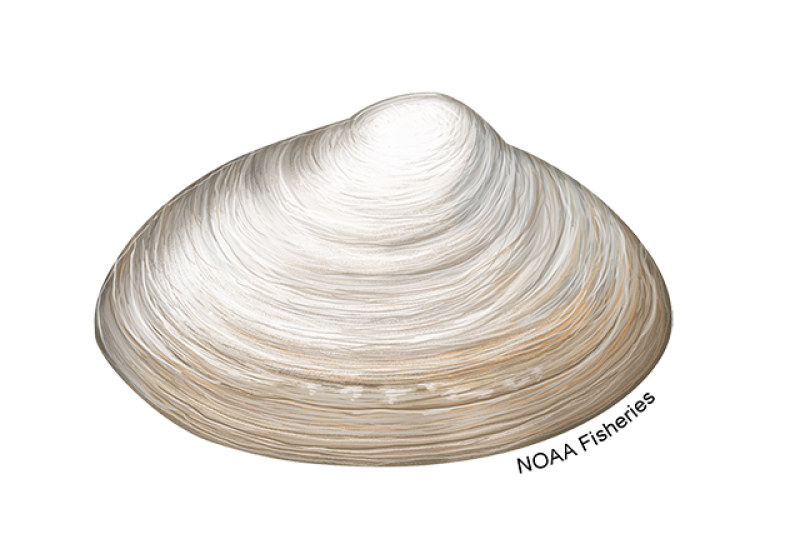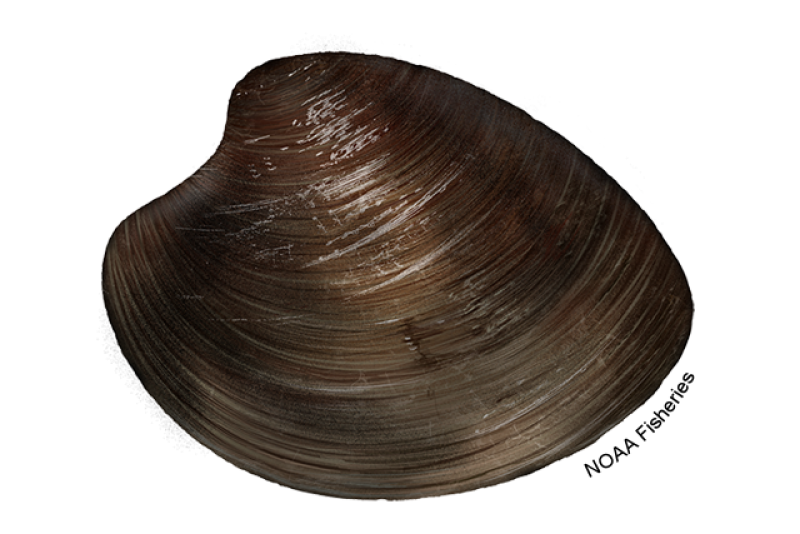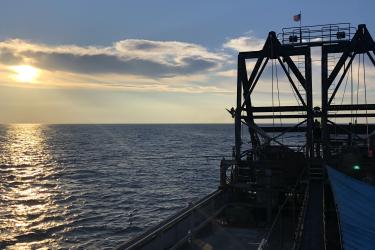Atlantic Surfclam
 Atlantic surfclams. Credit: Woods Hole Sea Grant
Atlantic surfclams. Credit: Woods Hole Sea Grant
Atlantic surfclams. Credit: Woods Hole Sea Grant
About the Species
 Atlantic surfclams. Credit: Woods Hole Sea Grant
Atlantic surfclams. Credit: Woods Hole Sea Grant
Atlantic surfclams. Credit: Woods Hole Sea Grant
Atlantic surfclams are distributed from the Gulf of St. Lawrence to Cape Hatteras, NC. The U.S. fishery generally concentrates on the populations off the coasts of New Jersey and the Delmarva Peninsula. Dredge and hand harvest are authorized in the commercial fishery, with hydraulic clam dredges being the primary gear type used. The recreational fishery is limited to hand harvest. Surfclams are generally processed for human consumption in soups, chowders, and stews; while a small portion of landings are also sold in the bait market. U.S. wild-caught Atlantic surfclam is a smart seafood choice because it is sustainably managed and responsibly harvested under U.S. regulations. Implementing regulations are found at 50 CFR part 648 subpart E.

Population
The stock is not overfished.

Fishing Rate
Not subject to overfishing.

Habitat Impact
Fishing gear used to harvest surfclams has negative impacts to habitat, but the fishery is managed to minimize these impacts, particularly to sensitive habitat.

Bycatch
Fishing gear used to harvest surfclams is designed to minimize bycatch.
Population Status
- According to the 2020 stock assessment the surfclam stock is not overfished and is not subject to overfishing. Summary stock assessment information can be found on Stock SMART.
Appearance
- Surfclams are the largest bivalves found in the western North Atlantic.
- They grow up to 8.9 inches, although clams larger than 7.9 inches are rare.
- Their shells are thick, triangular, and yellowish-white with rounded edges and concentric ridges.
- Shells do not close fully and gape slightly.
Biology
- Surflclams can live up to 35 years.
- On average, surfclams living in open water live longer than those living inshore.
- Surfclams grow fast, reaching a harvestable size of about 5 inches in 5 to 7 years.
- Growth rates depend on water temperature—southern surfclam populations in warmer water grow more slowly than the more northern populations.
- Some are able to reproduce by age 1, but most spawn by the end of their second year.
- Surfclams spawn from late spring through early fall.
- They shed their eggs and sperm directly into the water column.
- Larvae spend about 3 weeks in the water column as plankton before settling to the bottom to live.
- Surfclams are planktivorous filter feeders, straining tiny plants out of the water to eat.
- Larval surfclams eat algal cells.
- Adults primarily feed on diatoms, green algae, and naked flagellates.
- Snails, crabs, shrimp, and fish, including haddock and cod, feed on surfclams.
Where They Live
Range
- Atlantic surfclams are found in the western North Atlantic from the southern Gulf of St. Lawrence to Cape Hatteras, North Carolina.
- They’re most abundant on Georges Bank, the south shore of Long Island, New Jersey, and the Delmarva Peninsula.
Habitat
- Juveniles burrow in medium- to fine-grain sand in waters 30 to 80 feet deep.
- Adults prefer medium- to coarse-grain sand and gravel from beach zones to over 160 feet deep.
- Surfclams prefer more turbulent waters and bury themselves just below the sediment surface.
Fishery Management
- NOAA Fisheries, the Mid-Atlantic Fishery Management Council, and state resource management agencies manage the surfclam fishery.
- Managed under the Surfclam-Ocean Quahog Fishery Management Plan:
- Fishermen must have a permit to harvest surfclams.
- Individual transferable quota (catch shares) program – managers set an annual catch limit for federal waters and allocate it among individual fishermen or vessel owners. These quotas can be sold or leased.
- Minimum size, which can be suspended by managers if they can demonstrate the harvest of small surfclams is below a certain threshold.
- Closed areas due to environmental degradation or to toxins that cause paralytic shellfish poisoning (PSP).
- Fishermen harvesting surfclams from Georges Bank have additional requirements under the PSP testing protocol.
- Mandatory vessel monitoring systems.
- Fishermen must maintain and submit logbooks of each fishing trip to document catch.
- Surfclams support valuable fisheries in New Jersey and New York state waters (within 3 miles of shore); state authorities are responsible for managing these fisheries.
Harvest
- In 2023, commercial landings of surfclam totaled 26.9 million pounds and were valued at $34.4 million, according to the NOAA Fisheries commercial fishing landings database.
- Surfclams are the most important commercial clam species harvested in the United States.
- Commercial fishermen harvest surfclams with hydraulic clam dredges—essentially large, heavy sleds pulled along the sea floor. High-pressure jets blast water into the sediment, which temporarily liquefies it and allows a steel blade to pass through the first few inches of substrate and scoop the clams onto the dredge, where they are captured in a cage made of steel bars.
- Atlantic surfclams burrow into sandy bottoms on the continental shelf, an environment that is thought to recover quickly after a hydraulic clam dredge passes over it.
- The bars on commercial clam dredges are spaced several inches apart so they do not collect anything but the targeted surfclams.
- The surfclam fishery is managed under an individual transferable quota program that provides fishermen with more flexibility on when to fish, slows the pace of the fishery, and increases its efficiency, significantly reducing bycatch.
Scientific Classification
- Atlantic surfclams are found in the western North Atlantic from the southern Gulf of St. Lawrence to Cape Hatteras, North Carolina.
- They’re most abundant on Georges Bank, the south shore of Long Island, New Jersey, and the Delmarva Peninsula.
- Juveniles burrow in medium- to fine-grain sand in waters 30 to 80 feet deep.
- Adults prefer medium- to coarse-grain sand and gravel from beach zones to over 160 feet deep.
- Surfclams prefer more turbulent waters and bury themselves just below the sediment surface.
Fishery Management
- NOAA Fisheries, the Mid-Atlantic Fishery Management Council, and state resource management agencies manage the surfclam fishery.
- Managed under the Surfclam-Ocean Quahog Fishery Management Plan:
- Fishermen must have a permit to harvest surfclams.
- Individual transferable quota (catch shares) program – managers set an annual catch limit for federal waters and allocate it among individual fishermen or vessel owners. These quotas can be sold or leased.
- Minimum size, which can be suspended by managers if they can demonstrate the harvest of small surfclams is below a certain threshold.
- Closed areas due to environmental degradation or to toxins that cause paralytic shellfish poisoning (PSP).
- Fishermen harvesting surfclams from Georges Bank have additional requirements under the PSP testing protocol.
- Mandatory vessel monitoring systems.
- Fishermen must maintain and submit logbooks of each fishing trip to document catch.
- Surfclams support valuable fisheries in New Jersey and New York state waters (within 3 miles of shore); state authorities are responsible for managing these fisheries.
Harvest
- In 2023, commercial landings of surfclam totaled 26.9 million pounds and were valued at $34.4 million, according to the NOAA Fisheries commercial fishing landings database.
- Surfclams are the most important commercial clam species harvested in the United States.
- Commercial fishermen harvest surfclams with hydraulic clam dredges—essentially large, heavy sleds pulled along the sea floor. High-pressure jets blast water into the sediment, which temporarily liquefies it and allows a steel blade to pass through the first few inches of substrate and scoop the clams onto the dredge, where they are captured in a cage made of steel bars.
- Atlantic surfclams burrow into sandy bottoms on the continental shelf, an environment that is thought to recover quickly after a hydraulic clam dredge passes over it.
- The bars on commercial clam dredges are spaced several inches apart so they do not collect anything but the targeted surfclams.
- The surfclam fishery is managed under an individual transferable quota program that provides fishermen with more flexibility on when to fish, slows the pace of the fishery, and increases its efficiency, significantly reducing bycatch.
Scientific Classification
| Kingdom | Animalia | Phylum | Mollusca | Class | Bivalvia | Order | Venerida | Family | Mactridae | Genus | Spisula | Species | solidissima |
|---|
Last updated by NOAA Fisheries on 03/20/2025
Featured News
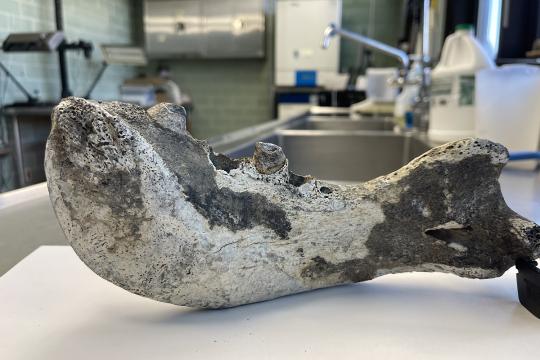 The right jawbone of a walrus, possibly thousands of years old, discovered during a NOAA dredge survey in 2024. Credit: NOAA Fisheries/Jonathan Duquette
The right jawbone of a walrus, possibly thousands of years old, discovered during a NOAA dredge survey in 2024. Credit: NOAA Fisheries/Jonathan Duquette
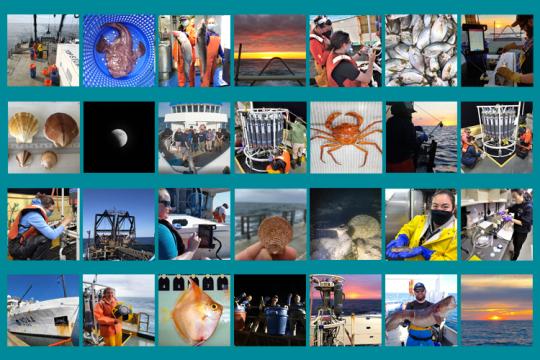
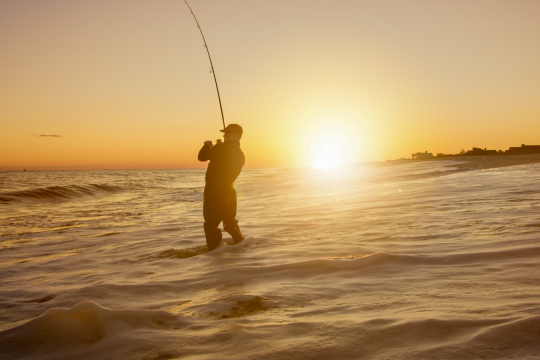
Changes in Ocean Conditions and Human Activities Impacted the U.S. Northeast Shelf Marine Ecosystem in 2020

Seriously Useful Seafood Tips: Shellfish and Other Farmed Seafood
Recreational Fishing Regulations
There are currently no recreational regulations for the Atlantic surfclam fishery. Check state regulations for possible additional restrictions. There may also be areas closed to the harvesting of Atlantic surfclams.
Recreational anglers must still comply with minimum fish size regulations for all recreational fisheries. Visit our permit office or recreational fishing pages for more information.
Reporting A Recreational Catch
This is not applicable for the Atlantic surfclam fishery. Visit the Greater Atlantic Region's recreational fishing page for more information about recreational reporting in general.
More Information
Last updated by NOAA Fisheries on 03/20/2025
Commercial Fishing Regulations
Possession and Size Requirements
There are no specified possession or trip limits in the Atlantic surfclam fishery. Instead, catch is limited on an annual basis according to each individual fishing quota (IFQ) holder’s annual allocation. Each permit holder essentially has their own personal quota/limit for the year, and the rate at which they harvest it is up to them.
The minimum length for surfclams is 4.75 inches. Length is measured at the longest dimension of the surfclam shell. No more than 50 surfclams in any cage may be less than the minimum size limit. If more than 50 surfclams in any inspected cage of surfclams are less than 4.75 inches in length, all cages landed on that trip are deemed to be in violation of the minimum size restriction. However, the minimum size limit is considered on an annual basis, and may be suspended. To determine if there is currently a minimum size limit for Atlantic surfclams, you may call the Sustainable Fisheries Division at (978) 281-9315.
Current Atlantic Surfclam Specifications (January 1-December 31, 2025)
| Acceptable Biological Catch (ABC) | 40,345 mt |
|---|---|
| Annual Catch Limit (ACL) | 40,345 mt |
| Annual Catch Target (ACT) | 29,363 mt |
| Commercial Quota | 3.4 million bushels (bu) |
Conversions
- 1 metric ton (mt) = 2,204.622 pounds (lb)
- 1 Atlantic surfclam bushel = 17 lb
Inseason Actions
There are provisions for the closing or opening of areas inseason, pending review.
Accountability Measures (AM)
If the ACL for Atlantic surfclam is exceeded, and the overage can be attributed to one or more ITQ allocation holder(s), the full amount of the overage will be deducted from the appropriate ITQ allocation in the following fishing year. Any amount of an ACL overage that cannot be otherwise attributed to an ITQ allocation holder will be deducted from the ACL in the following fishing year.
Reporting A Commercial Catch
Catch Reporting and Vessel Trip Reports (VTR)
The owner or operator of any vessel issued an Atlantic surfclam permit must maintain on board the vessel and submit to NOAA Fisheries an accurate Atlantic surfclam report for all fishing trips. More information and instructions for completing VTRs can be found on our region's reporting page.
Vessel Monitoring System (VMS)
Any vessel issued an Atlantic surfclam permit is required to have an operational VMS.
Other Reporting Information
The Atlantic surfclam fishery does not have any Interactive Voice Response (IVR) or specific observer requirements. However, all federally permitted vessels are obligated to carry an observer if randomly selected by the National Observer Program.
Commercial Gear Information
There are no specific gear requirements in the Atlantic surfclam fishery. However, all vessels issued a federal permit for the fishery and using cages must tag all cages that contain surfclams or ocean quahogs before offloading with a valid tag.
Federal Cage Tags
At the beginning of each fishing year, the approved vendor for cage tags is announced, and each individual fishing quota (IFQ) allocation permit is issued instructions for ordering the appropriate cage tags. The number of tags authorized for each permit holder is based on the owner's initial allocation and any allocation received through transfers. Each tag represents 32 bushels of clams.
A tag must be fixed on or as near as possible to the upper crossbar of the cage, and is required for every 60 ft3 (1,700 L) of cage volume, or portion thereof. The tag or tags must not be removed until the cage is emptied by the processor; at which time the processor must promptly remove and retain the tag(s) for 60 days beyond the end of the calendar year, unless otherwise directed by authorized law enforcement agents. If a vessel fishing under an IFQ allocation is not a capable of carrying cages, it must offload unshucked surfclams or ocean quahogs into properly tagged cages.
Tags expire at the end of the fishing year for which they are issued. If your tags are lost or stolen, you must notify NOAA Fisheries, with the number of the lost/stolen tags, by telephone at (978) 281-9177 as soon as the loss or theft is discovered and in writing within 24 hours. After a report is received, the reported tags are no longer valid for use. Lost or stolen tags may be replaced if the proper notice was provided. Replacement tags may be purchased from the vendor with a written authorization from NOAA Fisheries.
Last updated by NOAA Fisheries on 03/20/2025
Seafood Facts

Are Atlantic Surfclams Sustainable?
U.S. wild-caught Atlantic surfclam is a smart seafood choice because it is sustainably managed and responsibly harvested under U.S. regulations.
Availability
Year-round. Sold processed, rather than live, in fresh, frozen, and canned products such as breaded clam strips, minced clams, stuffed clams, chowders, and broth.
Source
U.S. wild-caught from New England to North Carolina. The United States is the only source of Atlantic surfclams.
Taste
When cooked, the white meat is mild and sweet.
Texture
Chewy.
Color
The raw meat is whitish-orange. Cooked meat ranges from ivory to golden yellow, with some dark areas.
Health Benefits
Surfclams provide low-fat, high-quality protein and are an excellent source of selenium and niacin.
Nutrition Facts
Servings: 1; Serving Weight: 100 g; Calories: 74; Protein: 12.77 g; Total Fat: 0.97 g; Total Saturated Fatty Acids: 0.094 g; Carbohydrate: 2.57 g; Cholesterol: 34 mg; Selenium: 24.3 mcg; Sodium: 56 mgMore Information
Clam Recipes
Looking for some ways to add clams into your rotation? We have you covered with these recipes for baked stuffed clams, clam chowder, and more!

Last updated by NOAA Fisheries on 03/20/2025
Seafood News
 Fresh-caught taʻape on ice. Credit: Conservation International Hawaiʻi.
Fresh-caught taʻape on ice. Credit: Conservation International Hawaiʻi.
Reducing Waste and Feeding Communities in Hawaiʻi with a Whole Fish Approach
 Chef Tyler Hadfield’s Curried Skate Wings with Tomato-Masala Chutney
Chef Tyler Hadfield’s Curried Skate Wings with Tomato-Masala Chutney
Ring In the New Year With These Crowd-Favorite Seafood Recipes
 NOAA Fisheries, in collaboration with Blue Ocean Mariculture, is conducting a multi-year pilot study to evaluate observational methods and tools for studying Hawaiian monk seal behavior. Courtesy of Blue Ocean Mariculture
NOAA Fisheries, in collaboration with Blue Ocean Mariculture, is conducting a multi-year pilot study to evaluate observational methods and tools for studying Hawaiian monk seal behavior. Courtesy of Blue Ocean Mariculture
AI Meets Aquaculture to Study Hawaiian Monk Seal Interactions With Net Pens
 Tonya Wick aboard a fishing vessel at sea in 1998. Photo courtesy of Tonya Wick
Tonya Wick aboard a fishing vessel at sea in 1998. Photo courtesy of Tonya Wick
Management Overview
The Atlantic surfclam fishery is managed by the Mid-Atlantic Fishery Management Council, with NOAA Fisheries serving as the implementing body for rules and regulations within the fishery. This fishery was established in 1977, and with the exception of the Maine mahogany quahog zone portion of the fishery, has operated under an individual transferable quota (ITQ) management system since 1990.
The fishing year runs from January 1 through December 31, with NOAA Fisheries jurisdiction covering from Maine to Cape Hatteras, North Carolina.
There are five areas closed to harvesting of Atlantic surfclams. For more information on these areas, visit our Surfclam/Ocean Quahog Closed Area page.
Specifications/Quotas
The Atlantic Surfclam Fishery Management Plan (FMP) requires the annual specification of catch and harvest limits for up to three years at a time. If specifications are not in place at the start of the fishing year, the existing specifications roll over until new regulations are finalized. Please check the Atlantic surfclam commercial fishing page for current specifications.
Regulatory History
- 1977 – Original FMP for Atlantic surfclam and ocean quahog approved.
- 1979 – Amendment 1 extended the moratorium in surfclam fishery through 1979.
- 1979 – Amendment 2 extended the FMP through 1981, divided the surfclam portion of the management unit into the New England and Mid-Atlantic Area, and introduced a “bad weather make up day.”
- 1981 – Amendment 3 extended the FMP indefinitely; also imposed a 5.5-inch minimum size limit, expanded fishing week, and put quota setting on a framework basis.
- 1984 – Amendment 4 increased maximum clam quotas and altered allocation distribution methods. It was implemented on an emergency basis for 180 days beginning 1 July 1984, but was subsequently determined structurally complete for review.
- 1985 – Amendment 5 extended size limit and required that cages be tagged.
- 1986 – Amendment 6 divided the New England Area into the Nantucket Shoals and Georges Bank Areas, the dividing line being 69° N. longitude.
- 1987 – Amendment 7 changed the quota distribution on Georges Bank to equal quarterly quotas.
- 1988 – Amendment 8 established an ITQ system; also allowed minimum size to be suspended from year to year, merged the New England and Mid-Atlantic areas into one management area, and authorized an experimental fishery for information purposes.
- 1991 – Size limit suspended for the year's fishing season due to the relatively low abundance of pre-recruit-sized clams (less than 4.3 inches) and the likely incentive under Amendment 8 to target beds of larger surfclams.
- 1996 – Amendment 9 revised overfishing definitions in response to scientific review by NMFS.
- 1998 – Amendment 10 placed a moratorium on entry to the Maine EEZ fishery.
- 1998 – Amendment 11 achieved consistency among Mid-Atlantic and New England FMPs on vessel replacement and upgrade provisions, permit history transfer and splitting and renewal regulations for fishing vessels issued Northeast Limited Access Federal Fishery permits.
- 1999 – Amendment 12 established new overfishing definitions, identified and described essential fish habitat, added framework adjustment procedure, and implemented operator permits.
- 2004 – Amendment 13 revised surfclam overfishing definition, addressed gear impacts to EFH, allowed for multi-year quotas, provided for a reversal of the suspension of the surfclam size limit, and allowed implementation of a mandatory vessel monitoring system (VMS).
- 2005 – Industry has lowest harvest since 2000, at 2.744 million bushels of surfclams, 81% of the 3.4 million bushel quota, due to market conditions.
- 2008 – Amendment 14 implemented standardized bycatch reporting methodology across Mid-Atlantic fisheries.
- 2008 – Framework 1 requires a vessel monitoring system (VMS) for vessels participating in the surfclam fishery to monitor closed areas and borders between state and Federal jurisdiction.
- 2011 – Amendment 16 specified mechanisms to set acceptable biological catch (ABC), annual catch limits (ACLs), and accountability measures (AMs).
- 2013 – Regulatory Amendment reopened a portion of the George Bank paralytic shellfish poisoning closed area to Atlantic surfclam and ocean quahog harvesting. To harvest in the reopened area vessels must follow a paralytic shellfish poisoning protocol.
- 2015 – Amendment 15 implemented Standardized Bycatch Reporting Methodology.
- 2015 – Amendment 18 eliminated the requirement for vessel owners to submit "did not fish" reports for the time periods when their vessel was not fishing; removed some restrictions for vessel listings on Federal fishing permits.
- 2016 – Amendment 17 established a cost recovery program for the ITQ fishery; changes how biological reference points are incorporated into the FMP.
- 2017 – Amendment 19 implemented management measures to prevent the development of new, and the expansion of existing, commercial fisheries on certain forage species in the Mid-Atlantic.
- 2018 – Framework 2 established a process for setting constant multi-year Acceptable Biological Catch (ABCs) and clarified the process for setting ABCs for each of the four types of ABC control rules.
- 2020 – Framework 3 established a requirement for commercial vessels with federal permits for all species managed by the Mid-Atlantic and New England Councils to submit vessel trip reports electronically within 48 hours after entering port at the conclusion of a trip. Framework 4 modified the Council's ABC control rule and risk policy. The revised risk policy is intended to reduce the probability of overfishing as stock size falls below the target biomass while allowing for increased risk and greater economic benefit under higher stock biomass conditions. This action also removed the typical/atypical species distinction currently included in the risk policy.
- 2022 – Amendment 20 established limits on how much quota share or annual cage tags an individual or business can hold or control over the course of a fishing year.
Last updated by NOAA Fisheries on 03/20/2025
Science Overview
NOAA Fisheries conducts various research activities on the biology, behavior, and population health of Atlantic surfclams. The results of this research are used to inform management decisions for this species.
Scientists from NOAA’s Northeast Fisheries Science Center, along with industry and academic partners, survey clam populations every three years and typically follow these surveys with a stock assessment.
For detailed information about stock status, management, assessments, and resource trends, you can search for Atlantic surfclam, and any other species of interest, using NOAA’s StockSMART web tool.
Atlantic Surfclams and Harmful Algal Blooms
Some species of algae cause Harmful Algal Blooms (HABs), which can have negative impacts on fish, marine mammals, birds, and humans. Contamination from HABs can have a huge impact on fisheries for Atlantic surfclams and other shellfish. For example, Alexandrium spp. cause HABs in New England that are commonly referred to as “red tides.'' During red tides, Alexandrium toxin becomes concentrated in shellfish. The shellfish themselves are not affected by the toxin, but eating shellfish tainted with this toxin can lead to paralytic shellfish poisoning (PSP), a potentially fatal human illness.
There are large-scale monitoring programs all along the Northeast coast to assess toxin levels in shellfish; if toxins are detected these areas are immediately closed to harvesting.
More Information
Recent Science Blogs
Last updated by NOAA Fisheries on 03/20/2025
Data & Maps
Clam Dredge Exemption Areas in the Great South Channel Habitat Management Area
Research
Fisheries Ecology in the Northeast
We study the relationship between marine life and their environment to support sustainable wild and farmed fisheries on the Northeast shelf, creating opportunities and benefits for the economy and ecosystem.
Current Research at Milford Laboratory
We develop probiotics for use in oyster hatcheries and perform studies in aquaculture gear as habitat for marine life, nutrient bioextraction studies, shellfish genetics research, offshore shellfish aquaculture potential, and shellfish responses to ocean…
Outreach & Education
Fisheries of the Northeast
More than 100 species, including finfish, shellfish, urchins, and seaweeds, are landed in the…
Last updated by NOAA Fisheries on 03/20/2025
